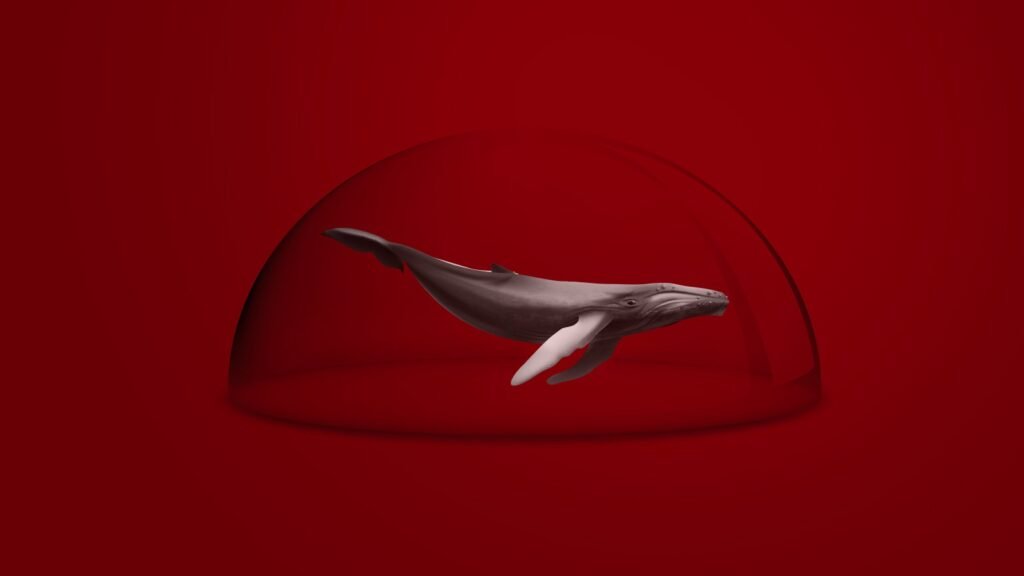Even before encountering one of the rarest mammals in the Gulf of Mexico, two amateur fishermen were already feeling fortunate. Positioned 35 miles off the coast of Pensacola, Florida, they had reached their favored spot, enjoyed a couple of Miller Lites, and successfully caught their third mahi-mahi when they were intrigued by the sound of air escaping a blowhole.
“Then you start looking,” recounted Ben Renfroe, who promptly grabbed his phone to capture the moment. “Is that a dolphin or a whale?”
However, dolphins in the Gulf are not known to surpass the size of motorboats. The dark figure Renfroe observed just before it submerged back into the water appeared much larger than his 26-foot craft. Moments later, the creature resurfaced, revealing a small dorsal fin and gliding its trunk over the waves akin to a surfacing submarine.
Upon reviewing the video onshore, experts reached a consensus: It was highly likely a Rice’s whale, one of the most endangered whale species globally. Authorities estimate that only around 51 of these whales remain, and they are exclusively found in the Gulf. To prevent their extinction, the U.S. government has set a limit, allowing no more than one to be killed or seriously injured by human activity every 15 years.
The primary threats to these whales are well-known. The National Oceanic and Atmospheric Administration (NOAA) has identified over 20 risks, including energy exploration in the Gulf, vessel collisions, and underwater noise. However, despite providing valuable scientific insights into the whales, NOAA has repeatedly postponed the implementation of regulations and measures that could enhance the whales’ chances of surviving these human-induced threats.
“The bureaucratic apparatus is slow to catch up,” remarked Aaron Rice, an ecologist specializing in whale studies (not related to scientist Dale Rice, for whom the whales are named). “It raises this philosophical question of values, like, how much do we value these animals that live in U.S. waters?”
“Shameful” delays for protections
On April 20, 2010, approximately 40 miles off the coast of Louisiana, the BP drilling rig Deepwater Horizon experienced a fire. In a span of two days, 11 workers lost their lives, and the rig ultimately sank. The well left in the aftermath would release over 200 million gallons of oil into the Gulf of Mexico over the following three months, marking it as the most extensive marine oil spill in history.
Rice’s whales were among the species most severely impacted by the disaster. Approximately one in five of them perished as the oil slick enveloped their habitat, and those that survived faced increased risks of illness or failed pregnancies. Consequently, their population dwindled to fewer than 100 individuals.
The Deepwater Horizon oil spill brought increased attention to Rice’s whales. Initially believed to be a subgroup of Bryde’s whales, researchers discovered, through bone analysis and genetic testing, that these whales constituted an entirely new species. The Gulf population was identified as the last of its kind globally, making the species exceptionally endangered.
Every individual became crucial in the conservation effort, as the extinction of Rice’s whales would have detrimental effects on the ocean’s ecosystem. These whales play a vital role in transferring nutrients between the seafloor and the surface, contributing to the ocean’s productivity. Additionally, their demise would result in the release of significant amounts of stored carbon dioxide, with each whale sinking about 33 tons of CO2 upon death. This environmental impact emphasizes the urgent need for U.S. action to safeguard these whales, as federal laws require prompt listing of endangered marine mammals and subsequent protection of their habitat.
NOAA has consistently failed to meet its deadlines, lagging in designating the habitat and formulating a recovery plan for the endangered Rice’s whales. Despite being added to the endangered species list, the agency’s delays prompted legal action from conservation nonprofits, which have sued NOAA multiple times since 2016 to compel adherence to legal requirements.
While NOAA acknowledges limitations in staffing and resources, critics argue that the agency’s repeated postponements are unacceptable, especially when dealing with a species on the brink of extinction. The delays raise questions about the agency’s commitment to fulfilling its responsibilities in a timely manner.
A group of nonprofits, frustrated with NOAA’s delays, petitioned the agency in 2021 to implement a speed limit to mitigate one of the immediate threats to Rice’s whales: ship strikes. Gulf ports, especially the port of Houston, are bustling with activity, and collisions with ships have resulted in the injury or death of two Rice’s whales since 2009. Research indicates that serious harm to whales from ship strikes is often caused by large vessels moving at high speeds.
The environmental groups proposed a safety measure, suggesting that ships with a length of 65 feet or more should reduce their speed to 10 knots or less when traversing a specific area of the whales’ habitat in the eastern Gulf. They also urged the agency to restrict travel in this zone beneath the Florida panhandle during nighttime when the whales are closer to the surface, making them more challenging to detect.
Slowing down ships to protect whales is not a novel concept. The North Atlantic Right whales, also endangered, have been safeguarded along the U.S. East Coast with a 10-knot speed limit for over a decade, proving effective according to research. Despite this, when NOAA sought public opinions on a similar proposal for Rice’s whales in the Gulf, the energy and marine industries, along with politicians from states heavily dependent on those sectors, vehemently opposed it. Rep. Clay Higgins, R-La., and Sen. Bill Cassidy, R-La., even introduced bills to block NOAA from implementing the speed limit, arguing potential negative impacts on commerce. Cary Davis, president of the American Association of Port Authorities, expressed concerns over the proposed speed limit, asserting it was overly broad and ill-conceived, particularly considering the limited number of Rice’s whales in the Gulf. NOAA subsequently rejected the nonprofits’ petition for a speed limit on October 27 after reviewing the feedback.
NOAA’s decision not to impose a mandatory speed limit for ships in the Gulf of Mexico, despite recommendations from environmental groups, has raised concerns about the continued threat to the endangered Rice’s whales. The agency cited a need to focus on other conservation priorities and expressed its intention to encourage voluntary speed reductions by vessel operators. However, an NPR analysis of ship traffic data revealed that 80% of ship journeys across the whales’ proposed critical habitat in 2022 exceeded an average speed of 10 knots. Without a mandatory limit, the risk of ship strikes remains a significant threat to the survival of Rice’s whales in the Gulf.
NOAA’s rejection of the petition for a mandatory speed limit for ships in the Gulf of Mexico has drawn criticism from environmentalists who argue that the decision is an impediment to the conservation of Rice’s whales. Ship strikes have already harmed more of Rice’s whales than are considered sustainable for the species’ survival. Critics view NOAA’s decision as a failure in conservation efforts and question the delay in implementing measures to protect the endangered species. The absence of noise limits also adds to the threats faced by Rice’s whales, as underwater noise is a known risk to their survival.
The Gulf of Mexico is considered one of the loudest underwater regions in the United States, and fast ships contribute significantly to underwater noise pollution. Propellers of ships traveling at speeds exceeding 10 knots generate intense cavitation noise, which is a major source of underwater sound pollution from the shipping industry. This noise, occurring near Rice’s whales, can disrupt their communication and behavior. While ship noise affects the whales, the impact of seismic air gun surveys is even more substantial, further highlighting the challenges faced by Rice’s whales in their habitat.
Air gun blasts are a prevalent source of underwater noise in the Gulf of Mexico, and they coincide with the low-frequency range used by Rice’s whales for communication. These blasts, used in seismic air gun surveys to locate oil and gas deposits, emit explosions of compressed air into the water for extended periods. The resulting pressure waves can penetrate miles beneath the seafloor, creating a constant blanket of human noise in the whales’ habitat. This additional anthropogenic noise poses a significant challenge to the communication and behavior of Rice’s whales.
There are technological alternatives available that can reduce the disruptive impact of air gun surveys on marine life. Some air gun technologies can survey the ocean up to ten times more quietly than conventional guns, offering a less intrusive option for conducting seismic surveys. Additionally, kits are available that can transform existing air guns into quieter versions, providing a more cost-effective solution than replacing every gun on a ship. These alternatives aim to mitigate the negative effects of underwater noise on marine species, including Rice’s whales.
Upgrading technology to quieter alternatives, while not inexpensive, is a feasible option to mitigate the impact of air gun surveys on marine life. Companies like Sercel offer alternative air guns that are more marine mammal-friendly, albeit at a cost of up to $10 million. However, this expense is relatively small compared to the substantial earnings of major energy companies operating in the Gulf. Chevron, ExxonMobil, Shell, and BP collectively earned around $160 billion in 2022.
Despite the availability of quieter alternatives, the government does not currently mandate their use in seismic surveys. While there are regulations against excessive noise on land, there are no limits on the amount of noise that can be emitted into the ocean. As a result, most approved seismic survey projects in the Gulf continue to use conventional Argun systems.
The industry asserts that its goal is not to harm whales, but the adoption of alternative technologies is hindered by concerns about efficiency. Companies argue that it will take time to effectively implement these technologies. The lack of regulations and concrete steps by NOAA to encourage the adoption of quieter technologies raises questions about the industry’s commitment to mitigating the impact of noise on marine life.
Environmental groups and scientists are expressing concerns that sightings of Rice’s whales may become increasingly rare. In an open letter to the Biden administration, they warned of a serious consequence: the potential for the first man-made extinction of a great whale species under U.S. watch.
In October, Ben Renfroe and his friend set out to test this prediction. They embarked on a search for Rice’s whales, hoping to replicate their earlier luck. After spending nearly 10 hours in the mammals’ habitat, covering over 100 miles around the Gulf of Mexico, they observed a few birds and accidentally hooked a shark with their fishing pole. The difficulty in locating Rice’s whales underscores the urgency of conservation efforts to prevent their decline.


